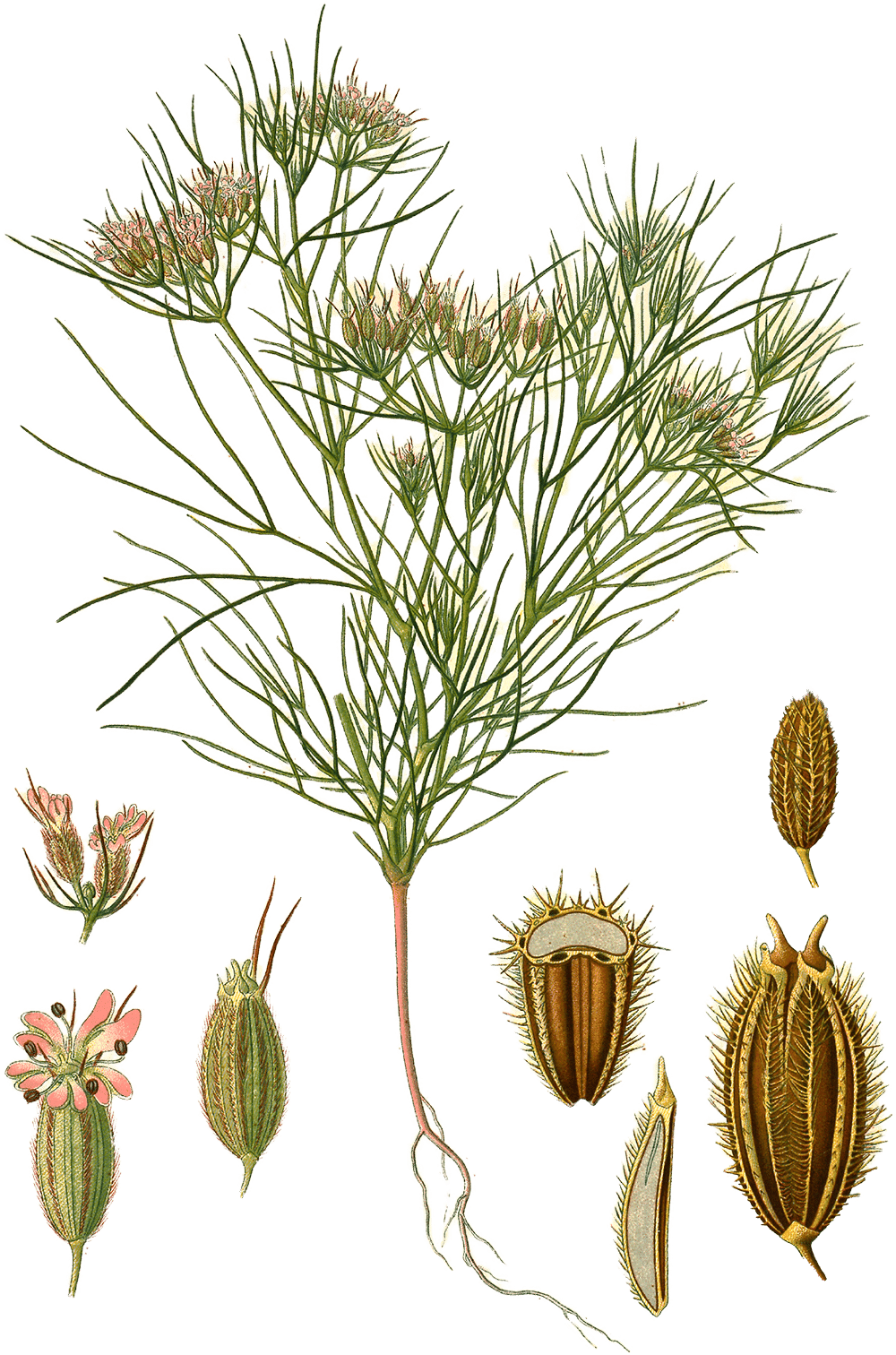Cumin #

Illustration of Cuminum cyminum L. from Köhler's Medizinal-Pflanzen (1887)
Cumin (Cuminum cyminum L.) is a culinary spice from the Apiaceae family,1 originating in the region(s) of W. & C. Asia; India .2 It is used for its fruit, primarily for curries, breads; colic. Its aroma is described as peppery, aromatic, with a heat index of 4.3
| English | Arabic | Chinese | Hungarian |
|---|---|---|---|
| cumin | كمون | 孜然 | római kömény |
Overview #
| id | cumin |
|---|---|
| species name | Cuminum cyminum L. |
| family | Apiaceae |
| part used | fruit |
| macroarea | Asia |
| region of origin | W. & C. Asia; India |
| cultivation | India; Iran; Lebanon |
| color | light brown |
| botanical database | POWO |
Etymologies #
English cumin, Middle English cumin, comin was either from French (like Middle Dutch comijn, Dutch komijn), or altered from Old English cymen after French. (Old English cymen); cf. cognates Old High German chumin, cumin, also chumil (Middle High German kümel, German kümmel), Swedish kummin, Danish kummen. The word has also come down in the Romanic languages, Italian cumino, comino, Spanish comino, Portuguese cominho, Old French cumin, comin. < Latin cumīnum ‘id.’ < Ancient Greek κύμῑνον kúmīnon ‘id.’, The Greek κύμῑνον is supposed to have been a foreign word, cognate in origin with the Semitic names < Semitic * kmn ‘id.’; cf. cognates Arabic kammūn; Hebrew kammōn; Akkadian kamūnu
Arabic كمون kammūn ‘cumin’ < Aramaic / kammōnā ‘cumin’; cf. cognates Old Armenian čʿaman < Akkadian Ú.GAMUN kamūnu ‘cumin’
Mandarin Chinese 孜然 zīrán ‘cumin’, modern loan from Uyghur (the historic term is 蒔蘿 from Middle Persian * zīra during Tang dynasty) < Uyghur زىرە zirä ‘cumin’ < Persian زیره zīra ‘cumin’, distantly related to Sanskrit jīraka (zire-ye siyāh [black cumin ] ‘caraway’; zire-ye sabz [green cumin ] ‘cumin’); cf. cognates Sogdian zyr’kk /zîrê/; Hindi-Urdu zīrā < Sanskrit जीर jīra ‘cumin’; cf. Hindi जीरा jīrā; English jeera
Names #
English #
| term | source |
|---|---|
| cumin | OED |
| cumin seed | OED |
Arabic #
| script | term | literal | source |
|---|---|---|---|
| كمون | kammūn | Wehr, 1976 | |
| سنوت | sannūt | Lane, 1863 |
Chinese #
| script | term | literal | source |
|---|---|---|---|
| 孜然 | zīrán | MDBG | |
| 阿拉伯茴香 | ālābó huíxiāng | Arabian fennel | MDBG |
| 安息茴香 | ānxī huíxiāng | Parthian fennel | MDBG |
| 茴香籽 | huíxiāngzǐ | hui-spice-seed | MDBG |
| 歐蒔蘿 | ōu shíluó | European dill | MDBG |
| 小茴香 | xiǎohuíxiāng | small-hui-spice-seed | Laufer, 1919 |
| 孜然芹 | zīránqín | cumin-celery | MDBG |
| 羅馬葛縷子 | luómǎ gělǚzi | Roman-caraway | |
| 馬芹子 | mǎqínzi | horse-celery-seed | |
| 枯茗 | kūmíng | withered-tea | MDBG |
| 蒔蘿 | shíluó | dill-turnip | Kleeman, 2010 |
POWO. (2022). Plants of the World Online (Botanical Database). Facilitated by the Royal Botanic Gardens, Kew. http://www.plantsoftheworldonline.org/ ↩︎
van Wyk, B.-E. (2014). Culinary Herbs and Spices of the World. University of Chicago Press, joint publication with the Royal Botanic Gardens, Kew. https://doi.org/10.7208/chicago/9780226091839.001.0001 ↩︎
Medicinal Spices Exhibit. (2002). UCLA Biomedical Library: History & Special Collections. https://unitproj.library.ucla.edu/biomed/spice/index.cfm?spicefilename=taste.txt&itemsuppress=yes&displayswitch=0 ↩︎